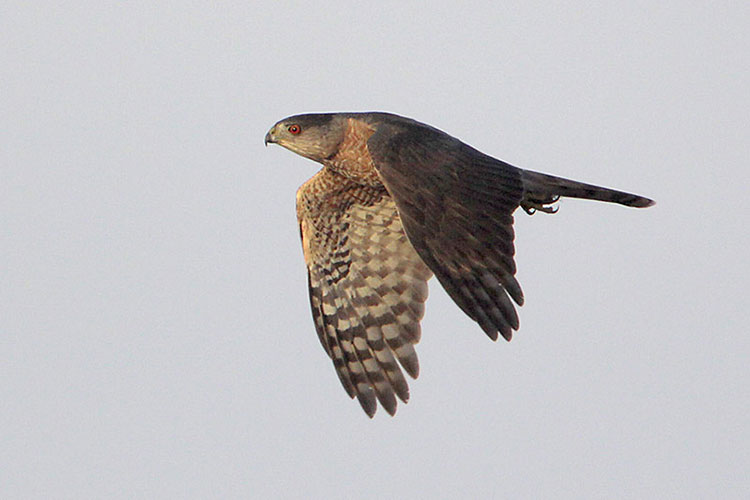Sharp-Shinned Hawks (Accipiter striatus) are fierce predators that soar through the skies with grace and agility.
These hawks are a common sight in North America, where they commonly inhabit dense forests and thickets. Also known as sharpies, they are a fascinating subject with their distinctive, sharp-looking shins and lightning-fast hunting tactics.
Despite their small size, they are powerful hunters and you can’t go wrong by learning more about them.
On this page
Breeding Male
Sharp-Shinned Hawks have 10 subspecies that differ slightly in appearance. The most common variant you can see in Northern America is the Northern Sharp-Shinned Hawk. They have long tails, short wings, and long legs.
The whole upper part of their body is bluish-gray, and their throat, upper belly, and breast are white with thick rust-colored barring, so they appear orangish. They have white on the lower part of their tail and abdomen.
Male Sharp-Shinned Hawks are smaller, being 9.1-11.8 inches long, weighing around 2.9-4.1 ounces, and having a wingspan of 17-23 inches.
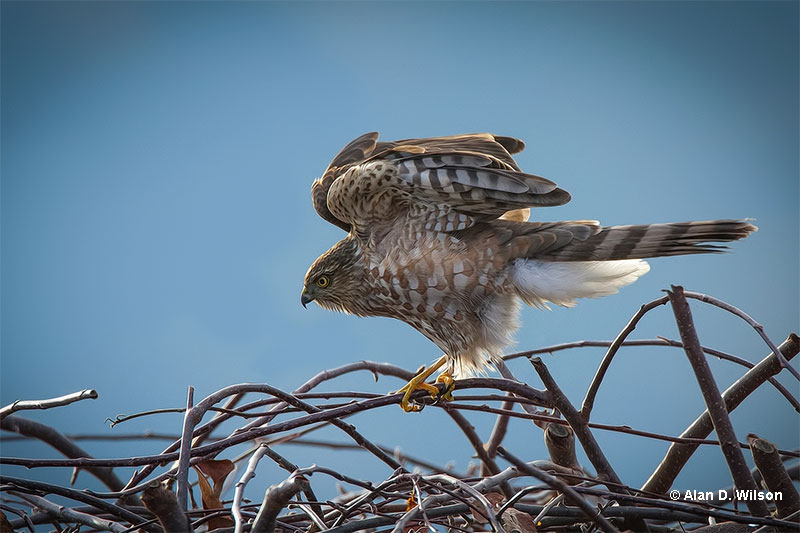
© Alan D. Wilson
Female
There are no apparent differences between the sexes other than the fact that the female Sharp-Shinned Hawks are one-third larger and heavier than their male counterparts. They can grow up to 11-15 inches long, weigh around 5.3-7.7 ounces, and have a wingspan of 23-27 inches.
Overall, the Sharp-Shinned Hawk is the smallest hawk in Canada and the United States.
Juvenile
These birds usually have one brood per year and 3-8 dull white or pale blue eggs splotched with brown, violet, or hazel. The eggs are 1.3-1.6 inches long, 1.1-1.3 inches wide, and take 30-35 days to incubate. Juveniles remain under the care and watchful gaze of their parents for about a month after they have learned to fly.
Juvenile Sharp-Shinned hawks are primarily brown and have coarse vertical bars. Depending on the subspecies, they are either grayer or browner than their adult counterparts, but all of them are more heavily barred and lack solid blue-gray wings and paler stomachs.
Habitat
Sharp-Shinned Hawks are widespread in North America and prefer to inhabit forests, and the edges of forests that are dense and ideally have a closed canopy for breeding. You can see them nesting in mixed or coniferous forests and thickets.
They are not found where there are scattered or little trees, except when they’re migrating, although when the breeding season is over, they can also be found in somewhat more open habitats with brushy areas, although they avoid completely open country.
You can meet them at many different elevations from near sea level and up to the tree line.
Diet
Sharp-Shinned Hawks are carnivores, with around 90% of their diet being small songbirds, such as warblers, thrushes, and sparrows. Sometimes they hunt bigger prey, such as quail, doves, and even other falcons. They also eat small mammals, such as mice and voles, insects, and young birds from nests.
These hawks are opportunistic hunters, keeping an eye on surroundings from a higher, hidden perch and darting out with a rush of speed to catch their prey. You can often see them hiding near bird feeders. They’re able to snatch their prey from the air but also from the ground, using their long and sharp talons to grab onto them and carry them away.
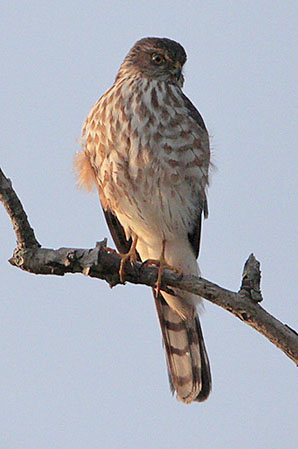
Unlike owls and some other hawk species, Sharp-Shinned haws pluck their prey before eating them. Since they get all the necessary hydration from eating their prey, they don’t need to drink water.
Both parents feed juveniles. Since the male of the species is smaller and catches mostly smaller prey, then he brings food when the nestlings are smaller. The female is bigger and able to catch bigger prey and feeds the young when they have grown a bit.
Behavior
These birds are territorial, quiet, and elusive during the breeding season. They nest in pairs in dense forests to avoid falling prey to other aerial predators. Intruders are chased away by calls and attacks. However, they get a bit more social during migration. You can see them traveling in small groups.

© Alan D. Wilson
Even when we leave out the fact that they’re carnivores and predators, you can often see them begging for a fight with larger birds of prey. They are more agile and are notorious for initiating aggressive play fights with bigger hawks and even eagles.
Sharp-shinned Hawks don’t interact with humans directly but have both positive and negative impacts on humans. They regulate the local small bird populations, therefore both reducing pest species but also killing domestic fowl and game birds.
Range (and seasonal changes)
Sharp-Shinned Hawks range across North America, Central America, South America, and the Greater Antilles, although again, different areas have different subspecies. North American hawks migrate to southern regions in the winter, although some in the northwestern regions may be permanent residents.
During migration, large numbers can be seen concentrating along coasts or ridges, but it’s important to note that they travel as individuals, not as a flock.
Wing shape
These birds have passive soaring wings that are short and rounded, often pushed forward. If you look up and see a Sharp-Shinned Hawk in flight, then you can see that it has a rust-colored breast, a square-tipped tail, and a white lower abdomen. The lower part of the wings are whitish-gray and its tail is barred with dark brown.
Sharp-Shinned Hawk’s flight could be described as 3-6 shallow and snappy wingbeats followed by a glide. They often take advantage of updrafts to save energy and are only seen flapping rapidly when chasing prey. They can appear unsteady while flying.
Fun Facts
- Sharp-Shinned Hawks can reach a speed of 60 miles per hour and fly as high as 13,000 feet.
- These birds have longer middle toes that help impale and anchor prey. They can even reach into wire mesh bird traps to grab prey that’s caught up there.
- Generally, the adults bring already killed prey to the nest for the nestlings to feed on. However, as they get older and more skilled, the parents start to drop live prey from mid-air for them to catch and kill, only giving them a warning call so they know to look out for it.
- Female, male, and baby hawks have their own terms. A female is called a hen, a male tiercel, and a baby hawk is called an eyas.
- Although they’re listed as species of least concern on the IUCN Red list since their numbers have increased, then that wasn’t always the case. Between 1940-1970, their population experienced a sharp decline in numbers due to an insecticide called DDT. It had devastating effects on its surroundings and wildlife but luckily became illegal in the 1970s.
Vocalization
Sharp-Shinned Hawk’s call is a series of high-pitched and fast kik-kik-kik sounds. You can hear them do this during courtship and the breeding season. It is also used as an alarm call and by young when they fledge. However, they’re usually relatively quiet.
You might also wonder what a nestling Sharp-Shinned Hawk sounds like. They, and also brooding females, give a single, longer, and high-pitched cheep sound when the male brings food to the nest.
Similar Species
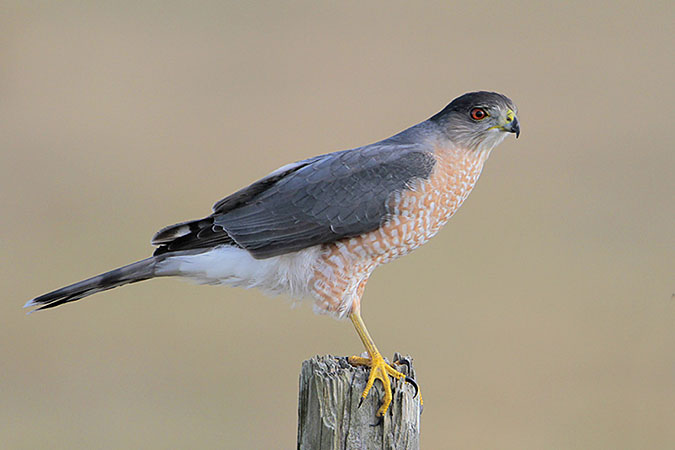
Cooper’s Hawk
At first, Sharp-shinned Hawks and Cooper’s Hawks look very similar. But when you look closer, Sharp-shinned Hawks have more brown on their throat and chest. Cooper’s Hawks have a lighter patch on the back of their neck, while Sharp-shinned Hawks have continuous grey plumage, from the top of their heads, down the back and wings.
If you have sharp eyes, take a look at the shape of their heads, Sharp-shinned Hawks have rounder heads, while Cooper’s Hawks have more square heads.
Apart from that, Sharp-shinned Hawks are noticeably smaller than Cooper’s Hawks.
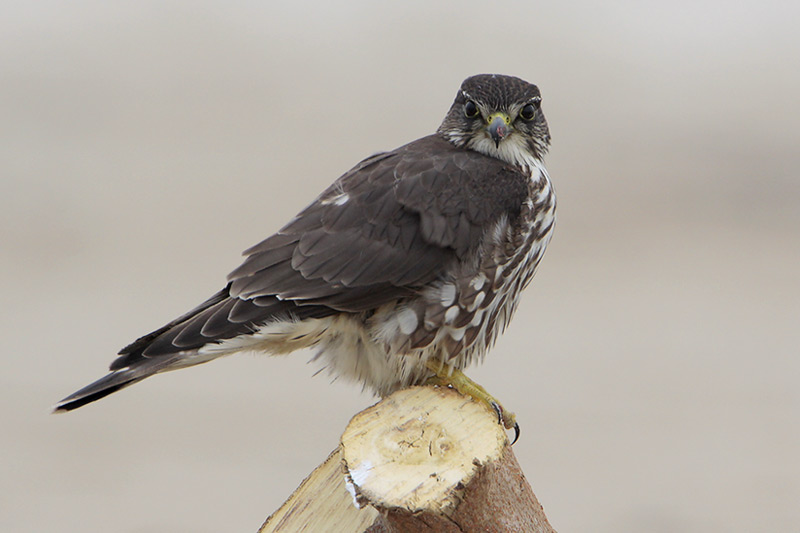
Merlin
Compared to Sharp-shinned Hawks, Merlins have darker brown in their plumage, especially on their chest and belly. Sharp-shinned Hawks have lighter brown plumage on their chest.
Sharp-shinned hawks have some barring on their chests, while Merlins have stripes running down their necks.
The two species are similar in size.
Frequently Asked Questions
Are Sharp-shinned Hawks rare?
Sharp-Shinned Hawks are quite common nowadays. Their population declined in the 1960s and 70s due to the use of a highly toxic insecticide called DDT, but since it’s been made illegal, their numbers grew and stabilized.
Why do they call it a Sharp-shinned Hawk?
Sharp-Shinned Hawk got its name after its sharp, flattened thin shins.

